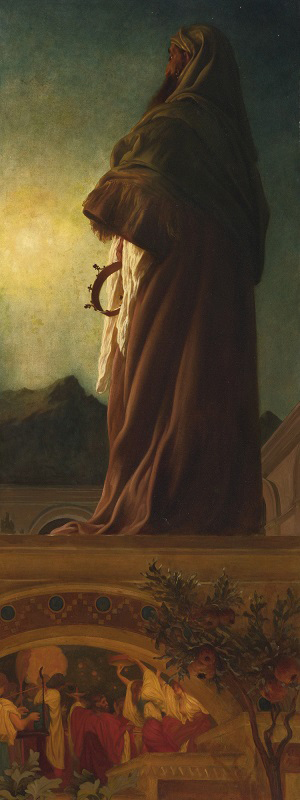Frederic, Lord Leighton, P.R.A. (British, 1830–1896)
The Star of Bethlehem, ca. 1862
Oil on canvas, 61 x 21 3/4 in.
2013.8

Frederic, Lord Leighton served as President of the Royal Academy of Arts from 1878 until his death in 1896, which established him as the most influential artist in Late Victorian England. A keen proponent of Classicism and a guardian of the academic tradition, he is best known for his works depicting classical subject matter. Born in England as the son of a doctor, Leighton spent much of his youth living on the Continent. His earliest artistic experiences occurred abroad, training at the Städelsches Kunstinstitut in Frankfurt from 1846−48 and 1850–52 (where he studied with the Nazarene artist Edward von Steinle), before moving to Rome in 1854 and then Paris from 1855–59. Leighton made his exhibition debut at the Royal Academy in England in 1855, where his Cimbaue’s Celebrated Madonna is Carried in Procession through the Streets of Florence (1853–55, National Gallery) was met with praise and purchased by Queen Victoria, thus establishing his artistic reputation within his home country. After settling in London in 1859, Leighton befriended members of the Pre-Raphaelite Brotherhood and was likewise critically supported by their champion, John Ruskin.
Although now best known for his innovative classical themes, in the 1860s Leighton created a series of biblical compositions including his powerful Star of Bethlehem. The subject of this work, which he exhibited at the Royal Academy in 1862, is a New Testament theme — though it does not reference a specific event in the Gospels. The bearded figure in a richly-draped robe could be identified as a number of biblical figures if not for the explanatory sentence included in the Royal Exhibition catalogue and in the inscription on the original frame’s plaque: “One of the Magi, from the terrace of his house, stands looking at the star in the East. The lower part of the picture indicates a revel, which he may be supposed to have just left.” Leighton chose to paint what he described as a “long and narrow” composition of a “somewhat fanciful” subject. With crown in hand, the king appears to have left behind the worldly pleasures of his palace (illustrated by the musicians and dancers in the painting’s lower register), as the starlight beckons him onto a spiritual journey. The disproportionate duality between the two realms and the radiant light emanating from the star give the painting a magical appeal.


